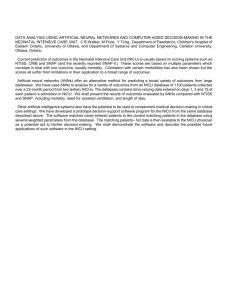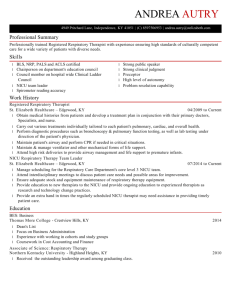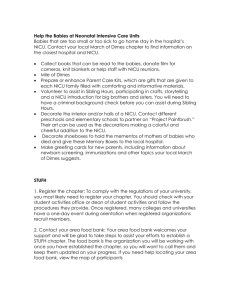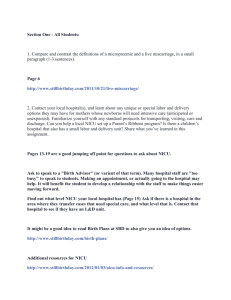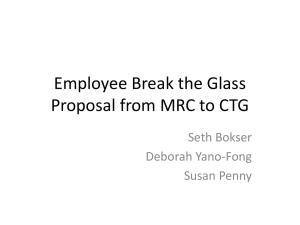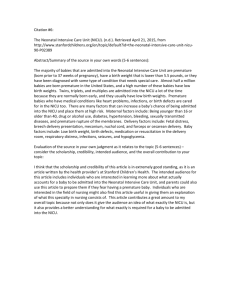View table C
advertisement
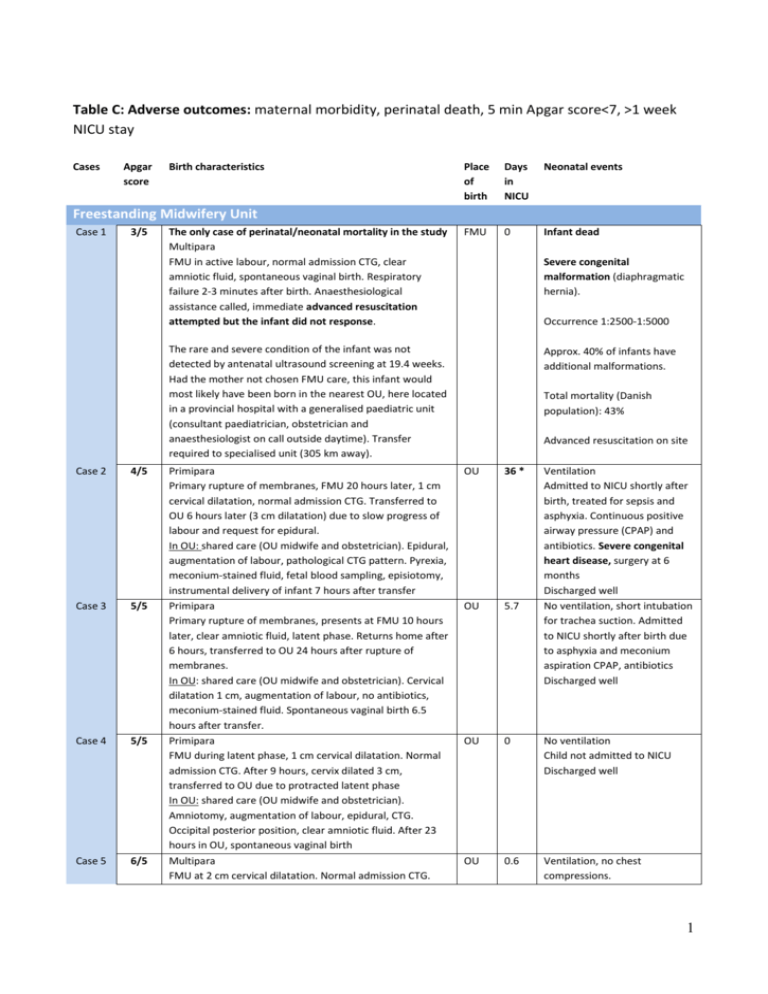
Table C: Adverse outcomes: maternal morbidity, perinatal death, 5 min Apgar score<7, >1 week NICU stay Cases Apgar score Birth characteristics Place of birth Days in NICU Neonatal events FMU 0 Infant dead Freestanding Midwifery Unit Case 1 3/5 The only case of perinatal/neonatal mortality in the study Multipara FMU in active labour, normal admission CTG, clear amniotic fluid, spontaneous vaginal birth. Respiratory failure 2-3 minutes after birth. Anaesthesiological assistance called, immediate advanced resuscitation attempted but the infant did not response. Severe congenital malformation (diaphragmatic hernia). Occurrence 1:2500-1:5000 The rare and severe condition of the infant was not detected by antenatal ultrasound screening at 19.4 weeks. Had the mother not chosen FMU care, this infant would most likely have been born in the nearest OU, here located in a provincial hospital with a generalised paediatric unit (consultant paediatrician, obstetrician and anaesthesiologist on call outside daytime). Transfer required to specialised unit (305 km away). Case 2 4/5 Case 3 5/5 Case 4 5/5 Case 5 6/5 Primipara Primary rupture of membranes, FMU 20 hours later, 1 cm cervical dilatation, normal admission CTG. Transferred to OU 6 hours later (3 cm dilatation) due to slow progress of labour and request for epidural. In OU: shared care (OU midwife and obstetrician). Epidural, augmentation of labour, pathological CTG pattern. Pyrexia, meconium-stained fluid, fetal blood sampling, episiotomy, instrumental delivery of infant 7 hours after transfer Primipara Primary rupture of membranes, presents at FMU 10 hours later, clear amniotic fluid, latent phase. Returns home after 6 hours, transferred to OU 24 hours after rupture of membranes. In OU: shared care (OU midwife and obstetrician). Cervical dilatation 1 cm, augmentation of labour, no antibiotics, meconium-stained fluid. Spontaneous vaginal birth 6.5 hours after transfer. Primipara FMU during latent phase, 1 cm cervical dilatation. Normal admission CTG. After 9 hours, cervix dilated 3 cm, transferred to OU due to protracted latent phase In OU: shared care (OU midwife and obstetrician). Amniotomy, augmentation of labour, epidural, CTG. Occipital posterior position, clear amniotic fluid. After 23 hours in OU, spontaneous vaginal birth Multipara FMU at 2 cm cervical dilatation. Normal admission CTG. Approx. 40% of infants have additional malformations. Total mortality (Danish population): 43% Advanced resuscitation on site OU 36 * Ventilation Admitted to NICU shortly after birth, treated for sepsis and asphyxia. Continuous positive airway pressure (CPAP) and antibiotics. Severe congenital heart disease, surgery at 6 months Discharged well No ventilation, short intubation for trachea suction. Admitted to NICU shortly after birth due to asphyxia and meconium aspiration CPAP, antibiotics Discharged well OU 5.7 OU 0 No ventilation Child not admitted to NICU Discharged well OU 0.6 Ventilation, no chest compressions. 1 Case 6 (7/5) Case 7 (7/5) Case 8 10/5 Transferred to OU 8 hours later because of no progress In OU: shared care (FMU midwife and obstetrician). Augmentation of labour, epidural. Pyrexia, antibiotics. Clear amniotic fluid. Caesarean section 5 hours after transfer because of pathological CTG Multipara FMU at 2 cm cervical dilatation, frequent painful contractions. Admission CTG with pathological pattern, emergency transferred to OU 1 hour after admittance. Tocolytic given for transfer, CTG pattern improves In OU: shared care (FMU midwife and obstetrician). CTG, Caesarean section 4 hours after transfer due to fetal distress. Abruptio placentae Primipara FMU at 1 cm cervical dilatation. Normal admission CTG. Transferred to OU 10 hours later at 7 cm cervical dilatation because of slow progress of labour In OU: shared care (OU midwife and obstetrician). Augmentation of labour, CTG, spontaneous vaginal birth 3 hours after transfer Adverse event with potential adverse outcome Multipara: Umbilical cord prolapse in multipara after spontaneous rupture of membranes. Local gynaecologist is summoned against protocol and an emergency caesarean section performed. Had guidelines been followed, the woman would have had a tocolytic, pelvic elevation, and the infant would have been pushed up vaginally while an emergency transfer was carried out (minimum duration 20 min.). The women would have been taken directly to the operating theatre where an obstetrician would decide on the further action. (case included in sensitivity analysis) Birth weight low for gestational age (2554 g). Child admitted to NICU for 14 hours, observation only Discharged well Ventilation, no chest compressions. Admitted to NICU shortly after birth. CPAP and antibiotics. 2 days later, acute apnoea: Intubation, ventilation and transfer Discharged well No ventilation Admitted to NICU shortly after birth for respiratory problems. CPAP Discharged well OU 12.5 ** OU 11 *** FMU 0 The event happened less than two months after the maternity unit had been turned into a FMU. The staff involved had previously worked closely together and chose not to follow the regional guidelines for emergency transfer from FMUs. Apgar score 10/1, 10/5. Infant and mother discharged well OU 0.4 OU 5 Ventilation, chest compression. Admitted to NICU for 9 hours, CPAP Discharged well Oxygen mask, no ventilation Obstetric Unit Case 9 4/5 Case 10 6/5 Case 11 6/5 Case 12 6/5 Multipara OU at 10 cm cervical dilatation, fast labour. No CTG. Meconium-stained amniotic fluid just before spontaneous vaginal birth The only case of severe maternal morbidity in the study (The incident also lead to neonatal morbidity). Multipara OU at 5 cm cervical dilatation. Epidural, augmentation of labour, continuous CTG. Meconium-stained amniotic fluid, fetal distress leading to caesarean section. Uterine rupture discovered. Postpartum haemorrhage>2500 ml. Peripartum hysterectomy. Primipara OU at 5 cm dilatation. No dilatation for two hours: Augmentation of labour, CTG, meconium-stained fluid. Spinal analgesia (saddle block), followed by short fetal bradycardia. Ventouse delivery 7.5 hours after admission Multipara OU at 5 cm cervical dilation. Admitted to NICU shortly after birth, hypertonia and respiratory problems. CPAP Discharged well OU 4.6 OU 3.7 No ventilation Admitted to NICU shortly after birth for respiratory problems. CPAP, antibiotics Discharged well No ventilation Admitted to NICU, hypertonia 2 Augmentation of labour, meconium-stained labour, continuous CTG, spontaneous vaginal birth Case 13 6/5 Multipara OU at 10 cm cervical dilation. No CTG, fast labour, clear amniotic fluid, spontaneous vaginal birth *Longest NICU stay in study **Second longest NICU stay OU 1.5 and respiratory problems. CPAP, treatment for seizures. Discharged well No ventilation Admitted to NICU for respiratory problems CPAP. Discharged well ***Third longest NICU stay 3
